|
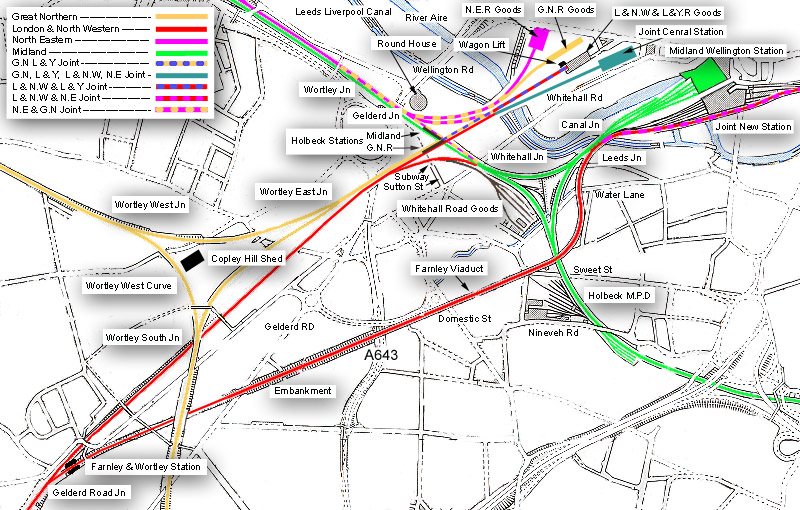 Leeds West Leeds West
Hybrid map
Roads 1980
Rails 1908
|
|
See also Leeds & West Yorkshire railway group -
http://flickr.com/groups/leedsrailways/ |
 Map
of Leeds (c1885) : Malcolm Mallison Map
of Leeds (c1885) : Malcolm Mallison
Map of Leeds, circa 1885. Note Middleton Railway, wending
north from H7, and Leeds & Selby Station (D9) which needs more
investigation. |
 Yorkshire
Film Archive c/o Graham Smith Yorkshire
Film Archive c/o Graham Smith
There is a superb little film on the Yorkshire
Film Archive that shows a speeded up train journey from Leeds Central to
Bradford Exchange in 1962. I think the makers may have used a bit of
poetic licence as I’m struggling to identify some sections, but there
are great views of the stations just out of Leeds before Pudsey,
Laisterdyke station with Quarry Gap before, St Dunstans and the approach
to Bradford Exchange. |
 
Joint Leeds City New Station (1869 - Present)
LNWR
NER |
Leeds City New (c1960s) : David Hey
 The
railway scene at Leeds has radically changed over the years, particularly
since the erection of steel masts and a curtain of overhead wires for the
£306 million East Coast Main Line electrification scheme which connected
the city with the main line at Doncaster in 1989. In the 1960s view, a
Class V2 reverses past the signal box on its way to Neville Hill shed,
whilst a Stanier tank fusses about with some parcel vans at the entrance
to the former MR (Wellington) station on the right. In the distance a
Metro-Cammel DMU heads past Leeds City East Junction, formerly Canal
Junction, and next to the gas holders on the right (now the site of the
present-day Armley gyratory road system) are the platforms of Holbeck High
Level station on the GN line out of Leeds Central. The inner-city canal
basin on the left has been completely transformed, whereas the dust
extractor tower (a copy of the famous Giotto's campanile at Florence)
remains a familiar landmark today. The
railway scene at Leeds has radically changed over the years, particularly
since the erection of steel masts and a curtain of overhead wires for the
£306 million East Coast Main Line electrification scheme which connected
the city with the main line at Doncaster in 1989. In the 1960s view, a
Class V2 reverses past the signal box on its way to Neville Hill shed,
whilst a Stanier tank fusses about with some parcel vans at the entrance
to the former MR (Wellington) station on the right. In the distance a
Metro-Cammel DMU heads past Leeds City East Junction, formerly Canal
Junction, and next to the gas holders on the right (now the site of the
present-day Armley gyratory road system) are the platforms of Holbeck High
Level station on the GN line out of Leeds Central. The inner-city canal
basin on the left has been completely transformed, whereas the dust
extractor tower (a copy of the famous Giotto's campanile at Florence)
remains a familiar landmark today. |
 Leeds
City New (c1980s) : David Hey Leeds
City New (c1980s) : David Hey
Comparisons can be made with this 1980s view, which
captures the exhaust of an 1C125 arriving from London Kings Cross. |
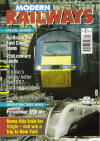 Modern
Railways” (April 1999) : Paul Holroyd website
- www.vintagecarriagestrust.org
See also Leeds Selby Modern
Railways” (April 1999) : Paul Holroyd website
- www.vintagecarriagestrust.org
See also Leeds Selby
The April 1999 issue of “Modern Railways” includes a
4-page feature on the Leeds First rebuilding project. |
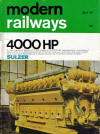 Modern
Railways (July 1967) :
Paul Holroyd Modern
Railways (July 1967) :
Paul Holroyd
The July 1967 issue of "Modern Railways" includes
a 9 1/2 page feature on the closure of Leeds Central and rebuilding of Leeds
City. |
 Plaque :
Paul Holroyd
website
- www.vintagecarriagestrust.org Plaque :
Paul Holroyd
website
- www.vintagecarriagestrust.org
Plaque commemorating the 1967 rebuilding of Leeds
City. |
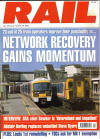 Rail
Magazine (2002) : Paul Holroyd Rail
Magazine (2002) : Paul Holroyd
Issue no. 437 June 2002 of "Rail" includes a
6-page feature on the Leeds First rebuilding programme. |
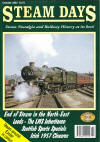 Steam
Days (2007) : Paul Holroyd Steam
Days (2007) : Paul Holroyd
The October 2007 issue of "Steam Days" includes an 18-page feature on
Leeds. |
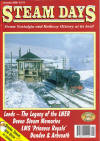 Steam
Days (2008) : Paul Holroyd Steam
Days (2008) : Paul Holroyd
The January 2008 issue of "Steam Days" includes a 17-page feature on
Leeds. |
 Leeds
City New c1970 : Philip Hardaker Leeds
City New c1970 : Philip Hardaker
Leeds station in the 1970s, took whilst train
spotting, it is a pity to keep these to myself I always feel people like
to look at times past. |
 Leeds
City New c1980 : David Webdale Leeds
City New c1980 : David Webdale
HST takes five. |
 Leeds
City New c1980 : David Webdale Leeds
City New c1980 : David Webdale
47 takes five. |
 Leeds
City New 1980s : David Webdale Leeds
City New 1980s : David Webdale
Unidentified Peak hauled passenger. |
 Leeds
City New c1980 : David Webdale Leeds
City New c1980 : David Webdale
High speed brass rubbing. An unidentified 55 pauses
on its way to Newcastle.
Wonder where these lads are now & if the rubbing still exists, hope so. |
 Leeds
City New 1980s : David Webdale Leeds
City New 1980s : David Webdale
Unidentified York bound Peak class. |
 Leeds
City New c1980 : David Webdale Leeds
City New c1980 : David Webdale
31405 pauses on the old platform 8 side of the
station. Dragonara hotel in the background. |
 Leeds
City New 1980s : David Webdale Leeds
City New 1980s : David Webdale
Peak & mixed freight. Dragonara hotel in the
background. |
 Leeds
City New c1970 : Philip Hardaker Leeds
City New c1970 : Philip Hardaker
Leeds station in the 1970s, took whilst train
spotting. Dragonara hotel in the background. |
 Leeds
City New c1970 : Philip Hardaker Leeds
City New c1970 : Philip Hardaker
Leeds station in the 1970s. Dragonara hotel in the background. |
 Leeds
City New c1970 : Philip Hardaker Leeds
City New c1970 : Philip Hardaker
Leeds station in the 1970s, took whilst train
spotting, facing west. |
 Leeds
City New c1970 : Philip Hardaker Leeds
City New c1970 : Philip Hardaker
Leeds City facing west. |
 Leeds
City New c1980 : David Webdale Leeds
City New c1980 : David Webdale
General view west. |
 Leeds
City New c1980 : David Webdale Leeds
City New c1980 : David Webdale
HST snakes in from the west. |
 Leeds
City New 1980s : David Webdale Leeds
City New 1980s : David Webdale
Unidentified 47 approaching from the west. |
 Leeds
City New 1980s : David Webdale Leeds
City New 1980s : David Webdale
Picturesque photo of a multiple unit, approaching
from the west. |
 Leeds
City New (03-87) : Michael Kaye Leeds
City New (03-87) : Michael Kaye
We are exiting Leeds PCD with 'A' line to the left, on the Gantry
(Right to Left are 'B' 'C' & 'D' Lines, the viaduct line off to left was
still in use at this date. March 1987. |
_small.jpg) Leeds
City New (c1985) : Michael Kaye Leeds
City New (c1985) : Michael Kaye
We are stood on ‘D’ line awaiting exit from Leeds Station, the parcels train
is leaving Leeds PCD and is our afternoon Leeds to Bradford Interchange job.
Also you can see the ‘viaduct Line’ which was at that time still well used. |
 Leeds
City New (10-07-86) : Michael Kaye Leeds
City New (10-07-86) : Michael Kaye
Entering Leeds on 'C' Line, to the right is the Motive Power area, and in
the distance is a Class 45 with Red Bank Parcels,
10th July 1986 |
 Leeds
City New (04-04-88) : Michael Kaye Leeds
City New (04-04-88) : Michael Kaye
Entering Leeds again on 'C' Line, now the Motive Power Area is gone, note on
the left of the picture,
the PCD Pilot,
this is now a car park, 4th April 1988. |
 Exiting Leeds
City New heading west (nd) : Philip Hardaker Exiting Leeds
City New heading west (nd) : Philip Hardaker
Leaving Leeds City station heading west the pictures
show ( on the left hand side) the old Leeds motive power area. |
 Exiting Leeds
City New heading west (nd) : Philip Hardaker Exiting Leeds
City New heading west (nd) : Philip Hardaker
As above and the banner repeater signal leaving
Leeds. |
 Exiting Leeds
City New heading west (nd) : Philip Hardaker Exiting Leeds
City New heading west (nd) : Philip Hardaker
Immediately to the left is where the old viaduct
line ran. |
 Exiting Leeds
City New heading west (nd) : Philip Hardaker Exiting Leeds
City New heading west (nd) : Philip Hardaker
Turn left to the old Holbeck motive power
department. |
 Exiting Leeds
City New heading west (nd) : Philip Hardaker Exiting Leeds
City New heading west (nd) : Philip Hardaker
Left to Holbeck MPD straight on for Whitehall
Junction. see Whitehall junction |
_small.jpg) Leeds
City New & Wellington (nd) : Michael Kaye Leeds
City New & Wellington (nd) : Michael Kaye
The fancy dust extractor tower of the Tower works
factory on Globe road Holbeck is visible on the left.
This is the biggest and most ornate of three towers. It was built in 1899 &
is based on
Giotto's Campanile in Florence. The factory closed in 1981. |
Leeds City New Station (10-04-07) : David Taylor
 People not familiar with Leeds may not be aware that when New Station was
completed in 1869 it was built on a massive complex
of vaults and arches
spanning the River Aire, the so called ‘Dark Arches’, reputedly comprising
18 million bricks, and the present station still sits on this great
Victorian complex.
In 1892 a fire in a tallow works beneath the station lasted two days and
caused severe damage and caused collapse of part of the station resulting in
closure of New Station for several weeks.
There is an old photo of the collapsed station held by Leeds library and
I'll try and get a copy. People not familiar with Leeds may not be aware that when New Station was
completed in 1869 it was built on a massive complex
of vaults and arches
spanning the River Aire, the so called ‘Dark Arches’, reputedly comprising
18 million bricks, and the present station still sits on this great
Victorian complex.
In 1892 a fire in a tallow works beneath the station lasted two days and
caused severe damage and caused collapse of part of the station resulting in
closure of New Station for several weeks.
There is an old photo of the collapsed station held by Leeds library and
I'll try and get a copy. |
 Leeds
City New Station (10-04-07) : David Taylor Leeds
City New Station (10-04-07) : David Taylor
Originally they were used as workshops and warehouses
and, until comparatively recently, comprised one of the most un-salubrious
parts of Leeds but today whilst some are still used as workshops most are
car parking and even retail units.
|

Wellington Station
Midland Railway |
/10%20wellington%20station%20south_small.jpg) Wellington
station facing South (02-04-05) : David Webdale Wellington
station facing South (02-04-05) : David Webdale
Wellington Station, was on the site of the present station car park and it
was dismantled in the late 60s.
The old stone viaduct leading into the station still visible.
Wellington
Station : David Taylor
I remember Leeds stations well from the 50s and 60s as I lived in
Harrogate but was at school in Leeds and then started work in Leeds so
travelled there daily by train for ten or more years. 'City Station' was
still not considered a single entity but often referred to by the names
of its two former stations - Wellington Station and New Station,
although they had organisationally amalgamated in the 1930s. This
wasn't surprising as the ticket barriers to the platforms of the two
former station were still totally separate from one another with
no access between their respective platforms once through the barriers.
|
Wellington
Station Concourse : David Taylor
 The platforms were accessed through ticket barriers from the Art
Decor concourse, which was built 1937ish to connect the two stations, and
the platform entrances are now occupied by the retail and fast food
outlets seen on the left hand side of the photo. The platforms were accessed through ticket barriers from the Art
Decor concourse, which was built 1937ish to connect the two stations, and
the platform entrances are now occupied by the retail and fast food
outlets seen on the left hand side of the photo.
The 'three' stations retained a degree of pre-nationalisation flavour:
'Central' was served almost exclusively by former LNER locos,
'Wellington' (or City North) by LMS and New (or City South) by a mixture
of both and BR standard locos. We used to get the Liverpool - Newcastle
(via Leeds/Harrogate/Thirsk) express home which came into 'New' hauled
by two LMS locos which were there changed for an LNER loco.
Nostalgia :
David Taylor
As I mentioned before I was at school in Leeds during the 1950s but lived
in Harrogate so for many years travelled back and forth by train. The
morning train went into Central Station and with school finishing at 3.50 we
could either leg it down to Holbeck Low Level and there get the stopping
4.13 from City South (New) Station. More leisurely a walk down to City
Station and get the 4.35 Liverpool – Newcastle Express (frequently packed
out with slightly the worse for wear National Servicemen) which came into
Leeds double-headed by two former LMS locos, having come over the Pennines
and then down the Calder Valley Line. In Leeds these were un-coupled and
replaced at the other end by an LNER loco, frequently an A3 Pacific, and
back out of the station the way it had come in but then taking the Harrogate
line. The line north of Harrogate to Northallerton closed to passengers in
1967 and to goods in 1969.
If for some special occasion we were let out of school before the last class
then we could get down to City Station and for a real treat get the 4.50 to
Harrogate via Wetherby but that route closed in 1964. |
 Plaque :
Paul Holroyd
website
- www.vintagecarriagestrust.org Plaque :
Paul Holroyd
website
- www.vintagecarriagestrust.org
1999 Ian Allan National Railway Heritage Awards.
Plaque commemorating the restoration of the 1930s north concourse. |
 Foundation
Stone :
Paul Holroyd Foundation
Stone :
Paul Holroyd
October 1936 foundation stone of Queens Hotel,
Leeds. |
_small.jpg) Leeds
PCD (nd) : Michael Kaye Leeds
PCD (nd) : Michael Kaye
Old Wellington station remnant. |
_small.jpg) _small.jpg) _small.jpg) Leeds
PCD (nd) : Michael Kaye Leeds
PCD (nd) : Michael Kaye
Loading bay. |
_small.jpg) _small.jpg) _small.jpg) _small.jpg) Leeds
PCD (nd) : Michael Kaye Leeds
PCD (nd) : Michael Kaye
Platforms |

  
Joint Central Station & goods depot (1857 -
1967)
LNWR
GNR
L&Y
NER |
Leeds Central
Leeds Central survived for 119 years, mainly as
the GNRs Leeds terminus.
The terminus was owned & built by the GNR, L&Y, Leeds Dewsbury &
Manchester, became part of LNWR in 1847 & Leeds & Thirsk Railway, became
part of NER in 1854.
Temporary station
The Leeds Central Station act was passed on 22nd July 1848.
The LNWR Leeds to Mirfield line opened
in 18th September 1848, so a terminus station with temporary facilities
was made on the land around what is now York Place,
Park Place, King street & Infirmary street. See above map.
This temporary terminus was used by four companies -
The LNWR from Huddersfield via Mirfield,
The L&Y from Manchester via the Calder
Valley Mainline & running over the LNWR
Leeds to Mirfield line.
The Leeds & Thirsk railway (later the NER) on 9th July 1849, via the
Gelderd curve, running uphill from the Midland railway.
The GNR on 1st October 1849, via the Midland railway from Methley junction
towards Armley & reversing up the Gelderd curve.
Moving out
Bored of waiting for the new permanent station to be built, three
companies moved out -
On 1st of May 1850 the Leeds & Thirsk (later the NER) moved its
operations to Midland Wellington station. Moved to the joint Leeds New
station on 1st April 1869.
On 1st October 1850 the LNWR moved to Midland Wellington station after the
opening of the curve between Copley & whitehall junctions.
On 14th May 1850 the GNR moved to its own temporary station along side its
low level goods depot.
Note : The LNWR & NER remained joint owners of the station but the GNR
withdrew its ownership.
Permanent station
By June 1852 a permanent station was completed on the same site as the old
one.
Only the L&Y were now using the station for trains from Manchester via
Dewsbury. Later trains came from Manchester Victoria via Halifax & Bowling
junction.
The L&Y did not have their own direct route to Leeds Central.
From 1st August 1854 the GNR resumed joint ownership of the station &
transferred all its passenger traffic back to high level Leeds Central.
On 1st May 1967 Leeds Central was closed & all traffic moved to Leeds New
station.
|
 Modern
Railways (July 1967) :
Paul Holroyd
website
- www.vintagecarriagestrust.org Modern
Railways (July 1967) :
Paul Holroyd
website
- www.vintagecarriagestrust.org
The July 1967 issue of "Modern Railways" includes
a 9 1/2 page feature on the closure of Leeds Central and rebuilding of
Leeds City.
|
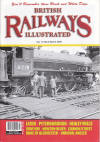 British
Railways Illustrated (March 2006) :
Paul Holroyd
website
- www.vintagecarriagestrust.org British
Railways Illustrated (March 2006) :
Paul Holroyd
website
- www.vintagecarriagestrust.org
British Railways Illustrated Vol 14 no 6 March
2006 includes a 12-page feature on Leeds. |
  Leeds
Central signs (30-06-12) : David Webdale Leeds
Central signs (30-06-12) : David Webdale
On display at the Middleton Railway |
 Central
station signs (30-03-23) : Paul Holroyd Central
station signs (30-03-23) : Paul Holroyd
This 1950s running in board from Leeds Central is awaiting display at
Vintage Carriages Trust's museum at Ingrow. |
 Central
station signs (16-05-23) : Paul Holroyd Central
station signs (16-05-23) : Paul Holroyd
Leeds Central sign on display at Vintage Carriages Trust's museum at
Ingrow. www.vintagecarriagestrust.org |
 Leeds Central (n.d) : Dave Walbank Leeds Central (n.d) : Dave Walbank
Leeds Central station |
 Leeds Central (n.d) : Dave Walbank Leeds Central (n.d) : Dave Walbank
Leeds Central station before demolition. |
 Leeds Central viaduct
(23-10-06) :
Phill Davison Leeds Central viaduct
(23-10-06) :
Phill Davison |
 Semaphore (12-09-10) :
David Webdale Semaphore (12-09-10) :
David Webdale
View from the roundhouse yard. See Roundhouse |
 Leeds Central viaduct
(23-10-06) :
Phill Davison Leeds Central viaduct
(23-10-06) :
Phill Davison
Driver’s eye view of the approach to central. |
 Leeds Central viaduct
(23-10-06) :
Phill Davison Leeds Central viaduct
(23-10-06) :
Phill Davison
The view overlooking Leeds city from the rather abrupt end of the viaduct. |
 Leeds Central viaduct
(23-10-06) :
Phill Davison Leeds Central viaduct
(23-10-06) :
Phill Davison
The central viaduct western approach towards Armley. |
 Leeds Central viaduct
(23-10-06) :
Phill Davison Leeds Central viaduct
(23-10-06) :
Phill Davison
All clear for the approach to central |
 Leeds Central viaduct
(23-10-06) :
Phill Davison Leeds Central viaduct
(23-10-06) :
Phill Davison
The incline section from Geldard jnct that runs nicely alongside Leeds new
apartment blocks. |
   Central
station & Goods high level approach (30-03-23) : Paul Holroyd Central
station & Goods high level approach (30-03-23) : Paul Holroyd
Part of the viaduct which led into Leeds Central station has been opened
up as a public footpath and garden. |
    Central
station & Goods high level approach (30-03-23) : Paul Holroyd Central
station & Goods high level approach (30-03-23) : Paul Holroyd
Part of the viaduct which led into Leeds Central station has been opened
up as a public footpath and garden. |
   Central
station & Goods high level approach (30-03-23) : Paul Holroyd Central
station & Goods high level approach (30-03-23) : Paul Holroyd
Bridge details. |
  Central
station & Goods high level approach (30-03-23) : Paul Holroyd Central
station & Goods high level approach (30-03-23) : Paul Holroyd
Bridge details. |
 Leeds Central viaduct
(23-10-06) :
Phill Davison Leeds Central viaduct
(23-10-06) :
Phill Davison
The end of the severed bridge makes city island look like a fortress |
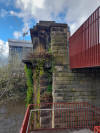   Central
station & Goods high level approach (30-03-23) : Paul Holroyd Central
station & Goods high level approach (30-03-23) : Paul Holroyd
Part of the viaduct which led into Leeds Central station has been opened
up as a public footpath and garden. |
 Leeds Central viaduct
(23-10-06) :
Phill Davison Leeds Central viaduct
(23-10-06) :
Phill Davison |
 Low
level Goods (23-10-06) :
Phill Davison Low
level Goods (23-10-06) :
Phill Davison
This is the remaining bridge stonework that spaned the canal that carried
the low level goods line. |
 Leeds
Central Viaduct (10-04-07) : David Taylor Leeds
Central Viaduct (10-04-07) : David Taylor
According to Stephen Batty (“Rail Centres: Leeds & Bradford ) the LD&MR
viaduct was comprised of 33 stone arches of 30’ span and 20 of 35’, and
as can be seen from David Hey’s photo of the wagon lift it was actually
a double viaduct. Today only 17 arches remain plus the elegant
ballustraded bridges over the Leeds & Liverpool Canal and the River Aire. |
 Leeds
Central Viaduct (10-04-07) : David Taylor Leeds
Central Viaduct (10-04-07) : David Taylor
Most of the remaining arches have been barely
visible due to the proximity of industrial buildings but as a result of
demolition works they can currently be seen together with a small section
of the second viaduct behind, not in photo. |
  Leeds
Central Viaduct (n.d) : Malcolm Mallison Leeds
Central Viaduct (n.d) : Malcolm Mallison
Leeds Central Viaduct. |
 Central
station & Goods high level approach (30-03-23) : Paul Holroyd Central
station & Goods high level approach (30-03-23) : Paul Holroyd
Part of the viaduct which led into Leeds Central station has been opened
up as a public footpath and garden. |
 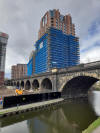 Central
station & Goods high level approach (30-03-23) : Paul Holroyd Central
station & Goods high level approach (30-03-23) : Paul Holroyd
Part of the viaduct which led into Leeds Central station has been opened
up as a public footpath and garden. |
/11%20central%20sta%20canal%20crossing%20south_small.jpg) Central
station & Goods high level approach : Canal crossing facing south
(02-04-05) : David Webdale Central
station & Goods high level approach : Canal crossing facing south
(02-04-05) : David Webdale
Standing between the canal & the river facing toward Holbeck.
There is evidence of the lower level N.E.R & G.N.R approach on the right.
An old semaphore signal is just visible up on the viaduct. |
/13%20central%20sta%20canal%20crossing%20west_small.jpg) Central
station & Goods high level approach : Canal crossing facing west
(02-04-05) : David Webdale Central
station & Goods high level approach : Canal crossing facing west
(02-04-05) : David Webdale
Same bridge different side, taken from the canal towpath. |
/12%20central%20sta%20river%20crossing%20east_small.jpg) Central
station & Goods high level approach : River crossing facing east
(02-04-05) : David Webdale Central
station & Goods high level approach : River crossing facing east
(02-04-05) : David Webdale
Standing between the canal & the river facing toward Leeds. |
/14%20central%20sta%20river%20crossing%20west_small.jpg) Central
station & Goods high level approach : River crossing facing west
(02-04-05) : David Webdale Central
station & Goods high level approach : River crossing facing west
(02-04-05) : David Webdale
Same bridge viewed from Whitehall road. |
  Central
station & Goods high level approach : River crossing (n.d) : Malcolm Mallison Central
station & Goods high level approach : River crossing (n.d) : Malcolm Mallison
Central station & Goods high level approach. |
   Central
station & Goods high level approach River crossing (30-03-23) : Paul
Holroyd Central
station & Goods high level approach River crossing (30-03-23) : Paul
Holroyd
Part of the viaduct which led into Leeds Central station has been opened
up as a public footpath and garden. |
|
 Central
station wagon lift : Photo David Walbank (c1980) : Info David Taylor Central
station wagon lift : Photo David Walbank (c1980) : Info David Taylor
With a capacity of 20 tons they were used to lift whole wagons from the low level G.N.R goods yard
up to the higher level L&Y.R sidings. This one used to lift wagons from a shed on
Whitehall road to sidings next to Central station.
Remaining L&Y & L&N.W viaduct brickwork still visible in this photo.
This is all that remained of Leeds Central Station at the time. |
/15%20central%20sta%20tower%20west_small.jpg) Central
station wagon lift : facing west (02-04-05) : David Webdale Central
station wagon lift : facing west (02-04-05) : David Webdale
Closer view same side 25 years later. Evidence of the L&Y, L&N.W viaduct arch
on this side. |
/16%20central%20sta%20tower%20east_small.jpg) Central
station wagon lift : facing east (02-04-05) : David Webdale Central
station wagon lift : facing east (02-04-05) : David Webdale
View from round the other side. This was the site of the lower
level G.N.R sidings.
Originally there were three wagon lifts on this site, two wagon lifts
visible in next photo. |
 Central
station wagon lift (30-03-23) : Paul Holroyd Central
station wagon lift (30-03-23) : Paul Holroyd
One of the few remaining clues to the location of Leeds Central station is
this goods wagon hoist. |
 Central
station wagon lift Blue plaque (30-03-23) : Paul Holroyd Central
station wagon lift Blue plaque (30-03-23) : Paul Holroyd
The Leeds Central station wagon hoist is commemorated by this blue plaque
- one of over 180 provided by the Leeds Civic Trust.
The Leeds Civic Trust has published two books giving details of the
places and people commemorated by their blue plaques scheme.
|

Holbeck low level station
Midland Railway |
 Entrance
to Holbeck station from Gelderd road (29-06-05) : RikJ Entrance
to Holbeck station from Gelderd road (29-06-05) : RikJ
Just to the south of the round house on Wellington road.
This entrance to the station, off Gelderd road, was via a subway between
the joint N.E , G.N line & the Midland line,
emerged between the railings in the centre of the platform. |
 Entrance
to Holbeck station Gelderd road (12-09-10) : David Webdale Entrance
to Holbeck station Gelderd road (12-09-10) : David Webdale
The view from above facing towards Leeds. The entrance just visible along
side that car.
An island platform was on top next to the bridges. |
 Entrance
to Holbeck station from Whitehall road (29-06-05) : RikJ Entrance
to Holbeck station from Whitehall road (29-06-05) : RikJ
See Map
This entrance via a long footpath from beneath the L & N.W.R & Midland
lines on Whitehall road. |
High & low Stations at Holbeck
Explanation : David Taylor
As a schoolboy I used the Low Level Station but
I do think that people who did not know it may be a bit confused by the
High Level/Low Level talk, so to explain. In effect it was two stations
one on top of the other connected by steps. The High Level station was on
a bridge and served GNR and L&Y lines which then continued over a viaduct
in to Central Station (see photos re Central Station). Below it was the
Low Level station on the MR lines from Wellington Station to the Aire
Valley and the NER New Station line to Harrogate. The primary purpose and
usage was as an interchange between the Central Station lines and the
lower lines from Wellington and New stations so that passengers could
change between these lines without having to cross between the city centre
stations. Unfortunately I've never seen a photo of High Level Station
taken from the Low Level platforms which would visually explain. |

Holbeck high level station
Great Northern Railway |
 Holbeck
high level station (23-10-06) :
Phill Davison Website -
http://www.flckr.com/photos/phill_dvsn/ Holbeck
high level station (23-10-06) :
Phill Davison Website -
http://www.flckr.com/photos/phill_dvsn/
This is the only remains of the much photographed Holbeck high level
station. |
 Holbeck
high level station (23-10-06) :
Phill Davison Holbeck
high level station (23-10-06) :
Phill Davison
The view from Whitehall jnct looking over the removed bridge section towards
Leeds.
I’m stood on the exact spot where platform 1 of Holbeck high level
was. |
 Holbeck
Subway Sutton Street entrance (02-07-05) : RikJ websites -
www.flickr.com/photos/rikj/
http://www.darkplaces.co.uk/ Holbeck
Subway Sutton Street entrance (02-07-05) : RikJ websites -
www.flickr.com/photos/rikj/
http://www.darkplaces.co.uk/
The subway runs from Sutton street, under the L.& N.W.R. Whitehall Branch,
under Holbeck G.N.R & emerged on what was Talavera street off
Gelderd road. (See map) |
 Holbeck
Subway (02-07-05) : RikJ Holbeck
Subway (02-07-05) : RikJ
Breezeblock and concrete section in the middle of
the subway,
may have originally been where the subway emerged out into the open.
|
 Holbeck
Subway Northern entrance (02-07-05)
: RikJ Holbeck
Subway Northern entrance (02-07-05)
: RikJ
Subway entrance at northern end. |

Round House
North Eastern Railway |
 Round
house (12-09-10) :
David Webdale Round
house (12-09-10) :
David Webdale
View from the footbridge over Wellington road along side the existing
tracks. Originally built for the Leeds & Thirsk Railway & opened in 1847.
The Leeds & Thirsk later became part of the NER. The architect was Thomas
Grainger & the building had 20 stabling bays. |
 Main
Entrance (12-09-10) :
David Webdale Main
Entrance (12-09-10) :
David Webdale
This was the only entrance up until 1864 when a further entrance was
added around to the right hand side facing the half round house.
By 1889 the bays were too small to house the bigger loco's being built at
the time.
In 1904 a new shed was built at Neville Hill & the NER moved out. |
 Main
Entrance (12-09-10) :
David Webdale Main
Entrance (12-09-10) :
David Webdale
The Main entrance, closer view. Since 1904 the building has had several
tenants including the West Leeds Motor Company in 1908.
Part of the building was used as a drill hall by the Leeds Rifles 1909-1916.
Thomas Marshall Engineers 1925-1970 & Leeds Commercial from 1969 to present. |
  Main
Entrance (12-09-10) :
David Webdale Main
Entrance (12-09-10) :
David Webdale
View from main entrance, the Leeds Central approach runs along side the
yard.
A semaphore remains. See Central
Station |
 Interior
(12-09-10) :
David Webdale Interior
(12-09-10) :
David Webdale
The view from just inside & to the right of the entrance. Some track
still in existence. |
 Interior
(12-09-10) :
David Webdale Interior
(12-09-10) :
David Webdale
The 20 stabling bays curve around the doors on the right leading out to
the central turntable.
The roof trusses are made from single pieces of timber 55ft in length. |
 Interior
(12-09-10) :
David Webdale Interior
(12-09-10) :
David Webdale
The view from the turntable area. The walls are stone built & originally
there was no roof over this section.
The turntable was 46ft 6" in diameter. |
 Interior
(12-09-10) :
David Webdale Interior
(12-09-10) :
David Webdale
Heavy wooden doors lead into the individual bays, this is the only one
remaining. |

Holbeck MPD
Midland Railway |
 Holbeck
(29-05-1967) : Roy Lambeth
Website -
www.dmm.org.uk/mindex.htm Holbeck
(29-05-1967) : Roy Lambeth
Website -
www.dmm.org.uk/mindex.htm
70046 b |
 Holbeck
(29-05-1967) : Roy Lambeth Holbeck
(29-05-1967) : Roy Lambeth
92082 |
 Holbeck
1 (c1980): David Walbank Holbeck
1 (c1980): David Walbank
The shed round house was on the left. |
 Holbeck
2 (c1980) : David Walbank Holbeck
2 (c1980) : David Walbank
The maintenance shed stands on the the site of the coal bunker for loading tenders. |
 Holbeck
approach (nd) : Michael Kaye Holbeck
approach (nd) : Michael Kaye
Drivers eye view. |
_small.jpg) _small.jpg) Holbeck
(nd) : Michael Kaye Holbeck
(nd) : Michael Kaye
General views. |
_small.jpg) _small.jpg) Holbeck
(nd) : Michael Kaye Holbeck
(nd) : Michael Kaye
General views. |
/7%20holbeck%20depot%20west_small.jpg) Holbeck
Depot facing West (02-04-05) : David Webdale Holbeck
Depot facing West (02-04-05) : David Webdale
Taken from Nineveh road. Farnley viaduct crosses in background. |
/6%20holbeck%20depot%20west_small.jpg) Holbeck
Depot facing West (02-04-05) : David Webdale Holbeck
Depot facing West (02-04-05) : David Webdale
Closer view, The brick engine shed on the left still survives.
|
Holbeck
British Rail notices
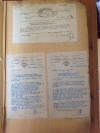 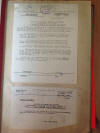 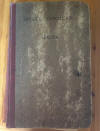 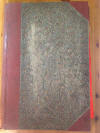 British
Rail notices
(1955-65) : Philip Hardaker British
Rail notices
(1955-65) : Philip Hardaker
I don't think you will have seen anything like this before! And
unfortunately you will not see any in the future because they are
unique.
When I was at Holbeck between 1979 and 1984 we had a cleaner and his
office was just inside the entrance to the car park. I was on nights and
I saw him dumping these large books.
When he went back into his office I went over to the dustbin and
retrieved both books and put them in the boot of the car! I have had
them since and they contain all the British Rail notices sent to Holbeck
from around 1955 through to about 1965. |
Holbeck Memories : David Walbank
I used to live in Keighley in Yorkshire years back. Every Saturday my
friend and I used to travel to Leeds by train steam pulled too, when we
got there we used to dash round to the Central Station in time to see the
Deltic pulled Pullman. Then round to Holbeck Steam Shed where we used to
climb a large wall and in through a broken window into the roundhouse
where we used to sneak around collecting numbers because they wouldn't let
you walk round.
Then we would walk up to Farnley Junction sneak round there and spend a
bit of time watching the trains pass and the engines move around. Then
either back to Holbeck or maybe go to Neville Hill or Copley Hill all
steam.
And then back home we used to spend all Saturday in Leeds we used to come
home blacker than the engine cleaners but we'd have about 200 numbers.
I still have a old Ian Allen Combine my last one I used in the 60's. I
have a picture in a book of Farnley Junction in a book somewhere if I can
find it I'll send it in. I have no photos of steam sadly I never took a
camera with me.
Wish I had now but I have books so it isn't so bad. I still remember the
Thames Clyde Express and The Waverley
come roarin' through Keighley, the station used to shake pulled either by
a Royal Scot class or Jubilee class engine. I also have sad memories of
what we'd call scrap trains , trains made up of engines stripped of their
runnin gear being towed away for scrap.
My favourite sound was 8f's or 9f's pulling a heavy freight train the deep
throbbing sound was unreal. |
   
Whitehall Junction
LNWR
GNR
NER
MR |
Whitehall Junction (05-1961) : David Hey
 The
two Anglo-Scottish expresses - ‘Thames-Clde’ and ‘Waverley’ – were hauled
by a variety of steam power north of Leeds, from 'Jubilees', 'Scots' and
BR Standard 'Britannia' classes, all based at Holbeck shed, but the most
surprising allocation during the 1960s was the nine Class A3s transferred
from Tyneside due to the cascading effect of dieselisation on the ECML. On
paper the A3s were Holbeck engines, yet all heavy maintenance such as
boiler wash outs were done at Neville Hill. The newly-acquired A3s were
welcomed by Holbeck crewmen, as most were fitted with the double Kylchap
blastpipe which produced a freer steaming engine and gave fireman an
easier time over the steeply-graded Settle-Carlisle line. Here Class A3 No
60086 Gainsborough The
two Anglo-Scottish expresses - ‘Thames-Clde’ and ‘Waverley’ – were hauled
by a variety of steam power north of Leeds, from 'Jubilees', 'Scots' and
BR Standard 'Britannia' classes, all based at Holbeck shed, but the most
surprising allocation during the 1960s was the nine Class A3s transferred
from Tyneside due to the cascading effect of dieselisation on the ECML. On
paper the A3s were Holbeck engines, yet all heavy maintenance such as
boiler wash outs were done at Neville Hill. The newly-acquired A3s were
welcomed by Holbeck crewmen, as most were fitted with the double Kylchap
blastpipe which produced a freer steaming engine and gave fireman an
easier time over the steeply-graded Settle-Carlisle line. Here Class A3 No
60086 Gainsborough
heads the northbound 'Thames-Clyde' though Whitehall Junction in May 1961.
The two turntables at Holbeck were found unsuitable for turning the
Gresley Pacifics - length 70ft 5ins - hence sister A3 No 60082 Neil Gow
(just visible in the right background) is being turned on the triangular
junction to the west of Leeds station, while an 'Austerity' is awaiting a
clear road on a down freight. |
Whitehall Junction (c1983) : David Hey
 Fast
forward twenty-odd years and Whitehall Junction has radically changed.
This 1983 view shows one of the 'First Generation' Class 108 dmus which
were built to designs conceived during the 1950s, but by the time this
photograph was taken the units were way past their best. BR began a
refurbishment programme in 1975 (repainting, improved heating and
ventilation, soundproofing and general improvements to the interior) which
may have been tangible proof of the worthiness of the old stock, but it
underlined the desperate need for more modern vehicles; it wasn't until
1984 that BR embarked on the replacement of its existing fleet with the
introduction of the second-generation dmus, including the new Class 14X
'Pacer' and Class 15X 'Sprinter' types. Fast
forward twenty-odd years and Whitehall Junction has radically changed.
This 1983 view shows one of the 'First Generation' Class 108 dmus which
were built to designs conceived during the 1950s, but by the time this
photograph was taken the units were way past their best. BR began a
refurbishment programme in 1975 (repainting, improved heating and
ventilation, soundproofing and general improvements to the interior) which
may have been tangible proof of the worthiness of the old stock, but it
underlined the desperate need for more modern vehicles; it wasn't until
1984 that BR embarked on the replacement of its existing fleet with the
introduction of the second-generation dmus, including the new Class 14X
'Pacer' and Class 15X 'Sprinter' types.
The junction is less than a mile from the city centre, yet the grassy bank
is like a green oasis amidst the industrial setting and noisy Armley
gyratory road system. |
 Exiting Leeds
City New heading west (nd) : Philip Hardaker Exiting Leeds
City New heading west (nd) : Philip Hardaker
Coming through Whitehall Junction. |
 Exiting Leeds
City New heading west (nd) : Philip Hardaker Exiting Leeds
City New heading west (nd) : Philip Hardaker
Coming off Whitehall Junction. |
 Exiting Leeds
City New heading west (nd) : Philip Hardaker Exiting Leeds
City New heading west (nd) : Philip Hardaker
Approach towards Holbeck East Junction. |

Whitehall Road Goods
Midland Railway |
 Whitehall
road goods (c1980) : C/O Michael Kaye with permission from Paul Corrie Whitehall
road goods (c1980) : C/O Michael Kaye with permission from Paul Corrie
Class 31 at Whitehall road goods. Armley jail (The
Castle) in the background. |

Copley Hill
LNWR |
 DMU
Copley Hill
: Bernard Coomber DMU
Copley Hill
: Bernard Coomber
56C Copley Hill. |
Copley Hill memories : Ian Jenkins
My granddad was a train driver in Leeds in the 50s and 60s. His name was
Tom Stoker (should have been a fireman with that name) At the age of
around 4, I rode the footplate with him from Town to Copley Hill where
he was based. Oh how I remember pulling the whistle. I am sure that is
why I have an interest in Leeds railways. I am 57 now but can still
remember how he smelled when he came home from work via the bookies and
the pub. He was always filthy from the coal but I suppose that is what
tap rooms were for back then. We lived in Cow Close grove right by
the Dunlop
and Ranken line. When he could he would climb the embankment and
footplate his way to work. Imagine that happening now lol.
During my life I have worked at Dunlop and Ranken and moved with Lye
Spencer Steel from Forge Lane Armley to the new building. (Guess where?
) yep right back to Copley hill where my Granddad used to work and where
my love of trains was born. How Ironic! |

Canal Junction - Farnley & Wortley (Farnley Viaduct)
London
& North Western Railway |
|
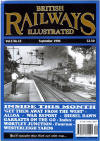 British
Railways Illustrated (September 1996) : Paul Holroyd British
Railways Illustrated (September 1996) : Paul Holroyd
The September 1996 issue includes a
14-page feature on Wortley Junction. |
 Gelderd
Road junction (C1967) : Michael Kaye Gelderd
Road junction (C1967) : Michael Kaye
The unit is
heading towards Wakefield and just to the right of unit is the bridge
where the original line went over the Leeds to Farnley railway.
In
the foreground is the new junction in which BR connected in 1966, from
Wakefield / Doncaster over the viaduct in to Leeds. |
 Gelderd
Road junction (30-07-86) : Michael Kaye Gelderd
Road junction (30-07-86) : Michael Kaye
Geldard Road Junction 30th July 1986, as you can see
the points are set for going over Farnley Viaduct.
This connection to the Leeds Wakefield line was made around 1967.
The red brick building on the left was part of Market Mill (flax). |
/17%20farnley%20viaduct%20gelderd%20rd%20jn%20east_small.jpg) Gelderd
Road junction facing east (10-04-05) : David Webdale Gelderd
Road junction facing east (10-04-05) : David Webdale
Same junction in 2005.
The sign behind the trees says Gelderd Road junction.
During October 1987 the Gelderd junction was removed & Farnley viaduct was
taken out of use.
The old track bed veers off to the right towards Gelderd road. Red brick
building just visible to the left. |
/19%20farnley%20viaduct%20underpass%20west_small.jpg) Great
Northern Leeds Wakefield underpass facing west (10-04-05) : David Webdale Great
Northern Leeds Wakefield underpass facing west (10-04-05) : David Webdale
Originally the track went underneath the G.N.R Leeds Wakefield line at
this point, through Farnley & Wortley station
& connected to the L.N.W.R Leeds Dewsbury line. |
/20%20farnley%20viaduct%20gelderd%20rd%20east_small.jpg) Gelderd
Road bridge facing east (10-04-05) : David Webdale Gelderd
Road bridge facing east (10-04-05) : David Webdale
Gelderd Road crossing Facing towards Leeds. |
/24%20farnley%20viaduct%20gelderd%20rd%20north_small.jpg) Gelderd
Road bridge facing north (10-04-05) : David Webdale Gelderd
Road bridge facing north (10-04-05) : David Webdale
View of the bridge from Gelderd road. |
/21%20farnley%20viaduct%20gelderd%20rd%20west_small.jpg) Embankment
& Track bed facing west (10-04-05) : David Webdale Embankment
& Track bed facing west (10-04-05) : David Webdale
Facing back along the embankment (A643 & Farnley viaduct behind
camera)
|
 Embankment Facing
south (c1980) : David Webdale Embankment Facing
south (c1980) : David Webdale
Taken from somewhere near Copley Hill, a romantic view of a Kings Cross
H.S.T on the same embankment back in 1980.
Elland road football ground visible in the background. |
 Farnley
viaduct facing east (30-07-86) : Michael Kaye Farnley
viaduct facing east (30-07-86) : Michael Kaye
Photograph was taken on 30th July 1986,
we are on the 'Down Line' entering the viaduct from Geldrard Junction, the
building on the right is Kays, |
/22%20farnley%20viaduct%20A643%20east_small.jpg) Farnley
viaduct facing east (10-04-05) : David Webdale Farnley
viaduct facing east (10-04-05) : David Webdale
Same place in 2005 facing towards Leeds at the start of the
viaduct.
The viaduct (fenced off from this point) starts here & crosses the A643.
Some track still remains. |
/23%20farnley%20viaduct%20side%20A643%20east_small.jpg) Farnley
viaduct facing east (10-04-05) : David Webdale Farnley
viaduct facing east (10-04-05) : David Webdale
View down the side. A643 passes under the second arch. |
 Farnley
viaduct facing south (02-05-05) : David Webdale Farnley
viaduct facing south (02-05-05) : David Webdale
Photographed from the A643 travelling slowly south. |
 Farnley
Viaduct (10-04-07) : David Taylor Farnley
Viaduct (10-04-07) : David Taylor
This has already been mentioned by Michael Kaye. In 1882 the L&NWR opened
a line from Wortley on the existing route to the west side of New Station
giving them independent access into New Station and avoiding the
congestion on the shared rails. |
 Farnley
Viaduct (10-04-07) : David Taylor Farnley
Viaduct (10-04-07) : David Taylor
The line ran extensively on the ¾ mile long Farnley
Viaduct of 83 arches and 10 girder bridges.
The line was closed in 1987 and the track subsequently taken up. |
/8%20holbeck%20depot%20north_small.jpg) Farnley
viaduct facing north (10-04-05) : David Webdale Farnley
viaduct facing north (10-04-05) : David Webdale
Taken from from Holbeck Depot (on left) facing towards Canal junction. |
 Farnley
Viaduct facing Leeds
(29-06-05) (RikJ) www.flickr.com/photos/rikj/
http://www.darkplaces.co.uk/ Farnley
Viaduct facing Leeds
(29-06-05) (RikJ) www.flickr.com/photos/rikj/
http://www.darkplaces.co.uk/
View from on the viaduct where it starts to curve round into Leeds City
Station. |
 Farnley
viaduct bridge (29-06-05) (RikJ) Farnley
viaduct bridge (29-06-05) (RikJ) |
 Farnley
Viaduct (20-10-10) : Phill Davison Farnley
Viaduct (20-10-10) : Phill Davison
The Leeds skyline has changed dramatically over the years. The ornate
towers of Tower works are today dwarfed by it's new neighbours.
This is pictured on top of the bridge across Bridge Road in Holbeck.
See the full set here -
http://blogs.myspace.com/ |
 Farnley
Viaduct (20-10-10) : Phill Davison Farnley
Viaduct (20-10-10) : Phill Davison
Above the City shot looking across Bridge Road towards the Farnley
direction. The roof you can see on the left is the Old Chapel on Czsar
Street in Holbeck. Low Hall Mills can be seen on the right of the picture. |
 Farnley
Viaduct (20-10-10) : Phill Davison Farnley
Viaduct (20-10-10) : Phill Davison
I love these subways and ginnels around the viaduct, there great for
atmospheric photos. The green board fixed to the fence (next to the small
subway) is where another footpath joined the ginnel from Water Lane. That
footpath has long since been disused. |
 Farnley
viaduct footpath 2 (19-06-05) (RikJ) Farnley
viaduct footpath 2 (19-06-05) (RikJ)
Now that's what I call litter. |
 Farnley
Viaduct (20-10-10) : Phill Davison Farnley
Viaduct (20-10-10) : Phill Davison
This place was littered with old fridges and gas cannisters when i first
looked down here four years ago. It's good to see it's been cleaned up
since then. I like the blue glow of daylight radiating into the tunnel on
this shot.
See the full set here -
http://blogs.myspace.com/ |
 Farnley
viaduct footpath 1 (19-06-05) (RikJ) Farnley
viaduct footpath 1 (19-06-05) (RikJ)
Maybe Victorian pedestrians were a lot taller than we are. |
 Farnley
viaduct footpath 3 (19-06-05) (RikJ) Farnley
viaduct footpath 3 (19-06-05) (RikJ)
That angle on the stone arch isn't perspective, it's
really like that! |
 Farnley
Viaduct (20-10-10) : Phill Davison Farnley
Viaduct (20-10-10) : Phill Davison
This is the much smaller subway built in 1846 by the Midland railway. The
subway has a slight kink in it for no apparent reason. The sun is in the
right position to highlight the interior tiles nicely here. You can see
the subway has been extended to accomodate extra track above at a later
date. Today hardly anyone uses these ginnels, there pretty much a
forgotten part of old Holbeck. See the full set here -
http://blogs.myspace.com/ |
    
Joint Holbeck East Junction
LNWR
GNR
NER
MR
L&Y |
Holbeck
East Junction (nd) : Michael Kaye
 The
photograph shows the original Holbeck Junc, the signal Box was on the right
with the entrance/exit to Leeds Central. The
photograph shows the original Holbeck Junc, the signal Box was on the right
with the entrance/exit to Leeds Central.
We are leaving the suburbs of Leeds on the ‘Up Line’ on our way to Wakefield
Westgate, the line off to the right is to Bradford Interchange and the line
off to the left is to Huddersfield, the 158 is waiting at the Junction after
its trip from Manchester, this line now comes in at the extreme left and no
connect
to Huddersfield/Manchester no longer exists. Middle Centre was Copley Hill
Depot. |
 Holbeck
East Junction (15-06-86) : Michael Kaye Holbeck
East Junction (15-06-86) : Michael Kaye
Holbeck East Junction, during re-modelling, the railway off to left as now
been taken out of use. 15th June 1986. |
 Holbeck
East Junction (15-06-86) : Michael Kaye Holbeck
East Junction (15-06-86) : Michael Kaye
This is Holbeck East Junction, 15th June 1986, we are entering Whitehall
Junction on the 'down' heading towards Leeds,
just to the left of the colour
light was Holbeck Low Level Station. Now this piece of railway as been
removed. |

Wortley West Curve
Great Northern Railway |
 Wortley
West Junction 31-12-06 : Phill Davison Wortley
West Junction 31-12-06 : Phill Davison
I was surprised there was so much intact (albeit in a dreadfull state)
since it was abandoned by B.R in 1985.
The mainline connection is still intact in the Bradford direction. |
 Point
of abandonment 31-12-06 : Phill Davison Point
of abandonment 31-12-06 : Phill Davison |
 Oldfield
Lane Bridge 31-12-06 : Phill Davison Oldfield
Lane Bridge 31-12-06 : Phill Davison
|
 Oldfield
Lane Bridge 31-12-06 : Phill Davison Oldfield
Lane Bridge 31-12-06 : Phill Davison
The overgrown state on top of Oldfield lane bridge. |
 Wortley
West Curve 31-12-06 : Phill Davison Wortley
West Curve 31-12-06 : Phill Davison |
 Wortley
West Curve 31-12-06 : Phill Davison Wortley
West Curve 31-12-06 : Phill Davison
Wortley signals |
 Wortley
South Junction 31-12-06 : Phill Davison Wortley
South Junction 31-12-06 : Phill Davison
The junction sign still intact the curve ran to the left & Copley Hill
shed was in the triangle spur ahead |




